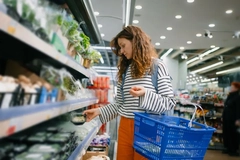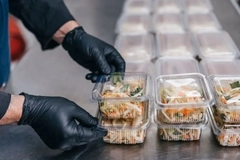Interpack live: ProAmpac and Stora Enso pioneer sustainable meat packaging without the bad smell

10 May 2023 --- Meat and fish products have some of the most stringent hygiene requirements in F&B packaging, with safety legislation and consumer appeal often outweighing environmental sustainability concerns. At Interpack 2023, we spoke with industry experts to learn of the latest R&D aimed at bridging the gap between environmental and public health risks.
Innova Market Insights found that meat and fish product launches are increasing globally, featuring a 6% year-over-year growth when comparing 2021 and 2022 launches. The market researcher also found that 61% of global consumers believe the increased use of plastic packaging is necessary – although perhaps undesirable – since the COVID-19 pandemic for safety reasons.
Ali McNulty, market manager for ProAmpac, explains that packaging meat and fish presents particular challenges, as it requires ensuring product freshness, preventing damage, complying with safety regulations and maintaining visual appeal.
“Meat and fish are highly perishable and can spoil quickly, so packaging solutions must provide puncture resistance, aroma barrier and extended shelf life to keep the products fresh for as long as possible,” she says.
“Packaging must also protect the products during transportation and storage to ensure freshness, preventing bruising or other damage. Additionally, packaging should be visually appealing, as consumers often make purchasing decisions based on appearance.”
 Stora Enso’s recently released Trayforma BarrPeel, consisting of 90% wood-based fibers.To overcome these challenges while continuing to make material and emissions reductions, manufacturers need to work with material scientists and look toward advanced barrier properties and active and intelligent packaging (A&IP) solutions, McNulty continues.
Stora Enso’s recently released Trayforma BarrPeel, consisting of 90% wood-based fibers.To overcome these challenges while continuing to make material and emissions reductions, manufacturers need to work with material scientists and look toward advanced barrier properties and active and intelligent packaging (A&IP) solutions, McNulty continues.
Breaking barrier hurdles
Traditionally, plastic film barriers ensure product safety, prevent repulsive aromas and extend product shelf life. However, with packagers aiming to reduce plastic usage and cut fossil fuel-based emissions, new renewable barrier materials that imitate the properties of plastic are continuously hitting the market.
Mandi Alaterä, senior vice president of communications and marketing at Stora Enso, tells us that fiber-based solutions are an increasingly viable option due to new technologies, such as the Trayforma BarrPeel, which was released last month.
“Recently, we have some novelties that are interesting for fish and meat, such as our single-use plastic-replacing paper that can be used in a vacuum-sealed tray,” she says.
“The tray material has two advantages: it stays in a pressed format, which was a challenge in the earlier days, but it also has an easy-peel function so the vacuum peel can be easily removed from the packaging.”
Trayforma BarrPeel consists of 90% renewable wood materials and has a special surface that allows an overlaying polymer skin film to be easily peeled.
“It’s a tradition in a way that we have used the properties of plastic – it’s easy to mold and form and packaging lines have been optimized for plastic. So we have to think outside the box and put some time into testing and make the carton board imitate plastic so that it would be really easy to switch,” explains Alaterä.  ProAmpac’s ProActive recyclable range of flexible films on display at Interpack 2023.
ProAmpac’s ProActive recyclable range of flexible films on display at Interpack 2023.
Fighting punctures, boosting efficiency
Meanwhile, McNulty says that ProAmpac’s product designs can increase material strength while reducing overall usage.
“In addition to vacuum pouches, film, modified atmosphere packaging (MAP), and flexible bags, we offer a range of specialized products to enhance product quality and durability,” she says.
“Our BoneGuard technology allows packers to use a thinner gauge plastic while still providing added puncture resistance, reducing the amount of plastic waste and increasing efficiency. ProAmpac also offers food boards used in the packing of smoked fish to support and showcase the product.”
The company’s newest product – ProActive Recyclable RP-1000 – was on display at Interpack 2023 and offers a paper option for frozen fish and seafood that is curbside recyclable.
The future of meat and fish packs
McNulty asserts that for the packaging industry to overcome the particular challenges surrounding meat and fish products, manufacturers must partner with experts in material science and technical knowledge.
“Technical expertise is required to select and design packaging solutions that meet specific product needs, such as puncture resistance and aroma barrier. Working with a partner who understands safety regulations can ensure compliance and avoid costly mistakes,” she says.
“Through collaboration and technical-to-technical communication, customized packaging solutions can be developed that address the unique challenges of packaging meat and fish, such as extended shelf life, aroma retention and visual appeal.”
 AI&P technologies can assure consumers that meat and fish products are safe to eat.She adds that A&IP technologies are quickly gaining traction in the food industry and are expected to impact meat and seafood packaging significantly.
AI&P technologies can assure consumers that meat and fish products are safe to eat.She adds that A&IP technologies are quickly gaining traction in the food industry and are expected to impact meat and seafood packaging significantly.
Active food contact materials absorb or release substances to improve the quality of packaged food or extend shelf life. Intelligent food contact materials monitor the condition of packaged food or the surrounding environment, for instance, by providing information on the freshness of the food.
“A&IP utilizes sensors and other technology to provide real-time information about product freshness and quality, which can help extend shelf life and reduce food waste,” McNulty details.
By monitoring factors such as temperature and humidity, A&IP can also alert consumers and distributors if products have been compromised during transportation or storage.
“As a result, A&IP can help ensure that meat and seafood products remain fresh and safe to consume while also providing consumers with valuable information about the products they purchase,” McNulty concludes.
By Louis Gore-Langton











